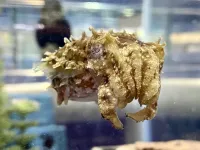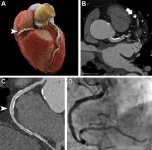(Press-News.org) Give credit to your dad’s gene for keeping you safe during those long months in your mother’s womb.
Because without this genetic warrior, you might have succumbed to any number of viral infections that otherwise could be fatal to a fetus. A new paper published this week in the journal Cell Host & Microbe explains the mechanisms behind this anti-viral protection.
“What’s unique about this gene is how it produces a form of defense for the baby in the womb,’’ said Hana Totary-Jain, PhD., associate professor of Molecular Pharmacology and Physiology and Heart Institute at the USF Health Morsani College of Medicine and senior author of the paper.
Their research focused on viruses that affect a pregnant mother and consequently her fetus, which are highly vulnerable to infection because their immune systems are immature. Some viruses, including Zika, rubella, and other serious infections, are rarely transmitted from mother to fetus in utero and can cause devastating consequences.
But the biological processes that protect a fetus from most viral infections are less clear. In the new paper, titled “SINE RNA of the imprinted miRNA clusters mediates constitutive type III interferon expression and antiviral protection in hemochorial placentas,’’ Dr. Totary-Jain and her team describe how a certain gene in the placenta is always armed for the battle.
“The placenta, in human and in mouse, is the first organ the fetus develops, and it is constantly exposed to maternal blood. This increases the chances of transmitting viral infections from the mother to the fetus. Therefore, the placenta has evolved robust defense mechanisms to prevent this transmission. We discovered a gene in the placenta that is expressed only from the paternal allele and produces a viral mimicry response. It tricks the placenta into thinking it’s infected and induces a constant state of antiviral defense”, Dr. Totary-Jain explained.
“So when we turned on this gene in other cells, we could protect the cells from several viruses. This is evolution’s way of protecting the baby. Without it, chances are you wouldn’t have made it into childbirth.’’
Ishani Wickramage, a PhD candidate in Dr. Totary-Jain’s laboratory and a lead author of the study added: “This research fills the gap in our knowledge about how many viruses that may infect a pregnant mother, including SARS-CoV-2, only rarely affect the fetus.’’
“Learning more about how the placenta shields the fetus from viruses also has important implications beyond childbirth,” said Dr. Charles Lockwood, MD, MHCM, one of the paper’s authors, who also is dean of the Morsani College of Medicine and executive vice president of USF Health.
“This is a novel placental mechanism that protects the developing fetus from transplacental transmission of most viruses,” Dr. Lockwood said. “This is the kind of knowledge that could lead to the development of new anti-viral medications to fight viruses that can be deadly for fetuses and newborn babies.”
This work was supported by a grant from the National Institutes of Health. Dr. Totary-Jain and a team of researchers at USF spent five years investigating this intriguing phenomenon in collaboration with Dr. Thomas Tuschl’s lab at Rockefeller University, who performed the sRNAseq and bioinformatic analysis, including researcher Klaas Max and Kemel Akat; and Drs. Kimiko Inoue and Atsuo Ogura from RIKEN and University of Tsukuba, Japan, who provided the mouse model that was used to show that the mouse placenta also developed the same mechanism to protect the fetus from viral infections.
Other USF Health members of the research team are: Jeffrey VanWye; John H. Lockhart; Ismet Hortu; Ezinne F. Mong; John Canfield; Hiran M. Lamabadu Warnakulasuriya Patabendige; Ozlem Guzeloglu-Kayisli; and Umit A. Kayisli.
— Story by Kurt Loft for USF Health News
END
USF Health researchers show how the placenta protects fetus in the womb against viral infections
2023-06-20
ELSE PRESS RELEASES FROM THIS DATE:
Outcome indicators make quality of life after childhood cancer measurable
2023-06-20
Outcome indicators make quality of life after childhood cancer measurable
A new measurement tool helps analyzing the survival rate of children with cancer, but also the quality of survival. Researchers at the Princess Máxima Center for Pediatric Oncology have worked with patients and survivors to develop a set of outcome indicators that measure health issues. By making the balance between survival and quality of life measurable, the outcome indicators help improve care for children with cancer.
There are many types of childhood cancer, and the consequences ...
Hidden mechanism connects cancer and diabetes
2023-06-20
Back in the 1920s, researchers discovered that cancer patients had sweet-smelling urine. First, the doctors were puzzled, but they soon realised that it was a result of elevated blood sugar levels.
“This was one of the first things we learned about cancer patients,” says Associate Professor Lykke Sylow.
The sweet-smelling urine suggested that cancer affects the body’s blood sugar level. But how? A new study is ready to answer that question. Where previous studies have examined the connection between cancer and insulin, Lykke Sylow and colleagues’ ...
The meaning behind the Woodstock character in ‘Peanuts’
2023-06-20
COLUMBUS, Ohio – Charles Schulz, creator of the comic strip “Peanuts,” was anything but a hippie.
Still, he named the beloved yellow bird character in “Peanuts” Woodstock after the famous counterculture music festival that was attended and celebrated by the younger generation who grew up in the 1960s and ’70s, including many who saw themselves as hippies.
The question is why, says Michelle Ann Abate, author of the new book Blockheads, Beagles, and Sweet Babboos: New Perspectives on Charles M. Schulz’s Peanuts.
Based on her critical analysis of the strips featuring Woodstock, ...
Restoring the blood-brain barrier?
2023-06-20
There's a bouncer in everyone: The blood-brain barrier, a layer of cells between blood vessels and the rest of the brain, kicks out toxins, pathogens and other undesirables that can sabotage the brain's precious gray matter.
When the bouncer is off its guard and a rowdy element gains entry, a variety of conditions can crop up. Barrier-invading cancer cells can develop into tumors, and multiple sclerosis can occur when too many white blood cells slip pass the barrier, leading to an autoimmune attack on the protective layer of brain nerves, hindering their communication with the rest of the body.
"A leaky blood-brain barrier is a common ...
Combining cancer-targeting virus therapy with radiation to fight brain cancer works better than either treatment on its own: study
2023-06-20
EDMONTON — Combining a cancer-targeting virus with radiation to treat brain cancer in mice was more effective than either therapy on its own according to University of Alberta research, providing hope for new treatments that combine immunotherapy with traditional surgery, chemotherapy or radiation.
The researchers treated mice with glioblastoma brain tumours simultaneously with high-dose radiation and a genetically engineered oncolytic vaccinia virus, a virus that has been used safely as a vaccine against smallpox.
The ...
Exploring the deep connections between adolescent sleep and overall health
2023-06-20
As director of SRI’s Human Sleep Research Program, Fiona Baker studies the complex interplay between sleep and overall health and well-being.
Much of her work has been focused on sleep patterns in adult women, but recently her attention has turned to adolescents. Adolescence is a crucial time for developing healthy sleep patterns as it is for brain development. In her research, Baker draws clear lines of connection between the two.
“Sleep is so important to us all, but especially for teenagers or adolescents,” Baker says. “Between the ages of 10 and 21, or so, and even a little later, the ...
SRI seeks to learn how insects speak through smells
2023-06-20
All around us, insects are speaking to each other: jockeying for mates, searching for food, and trying to avoid becoming someone else’s next meal. Some of this communication is easy to spot—like the flashes of fireflies on a summer night or a screaming chorus of cicadas in the afternoon—but many of the most sophisticated conversations are challenging to observe, occurring through an exchange of chemical scents.
Understanding chemical communication could be the key to finding new, more effective ways to protect crops or ward off biting insects that can transmit diseases. Researchers ...
Cuttlefish brain atlas first of its kind
2023-06-20
NEW YORK, NY — Anything with three hearts, blue blood and skin that can change colors like a display in Times Square is likely to turn heads. Meet Sepia bandensis, known more descriptively as the camouflaging dwarf cuttlefish. Over the past three years, a team led by neuroscientists at Columbia’s Zuckerman that includes data experts and web designers has put together a brain atlas of this captivating cephalopod: a neuroanatomical roadmap depicting for the first time the brain’s overall 32-lobed structure as well its cellular organization.
The ...
Climate action plans mobilize limited urban change, researchers report
2023-06-20
The Intergovernmental Panel on Climate Change Fifth Assessment Report (AR5), released just prior to an international climate convention in 2015, explicitly stated that human-caused greenhouse gas emissions were the highest in history, with clear and widespread impacts on the climate system. Since then, hundreds of cities across the world have published their own climate action plans (CAPs), detailing how their urban areas will handle climate change. How do the plans stack up against one another and against the recommended ...
Photon-counting CT noninvasively detects heart disease in high-risk patients
2023-06-20
OAK BROOK, Ill. – New ultra-high-resolution CT technology enables excellent image quality and accurate diagnosis of coronary artery disease in high-risk patients, a potentially significant benefit for people previously ineligible for noninvasive screening, according to a study published in Radiology, a journal of the Radiological Society of North America (RSNA).
Coronary artery disease is the most common form of heart disease. Coronary CT angiography (CCTA) is highly effective for ruling out coronary artery disease ...


